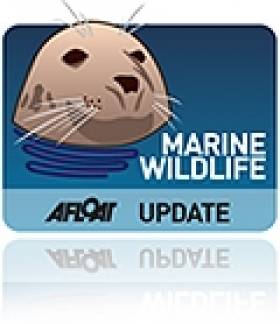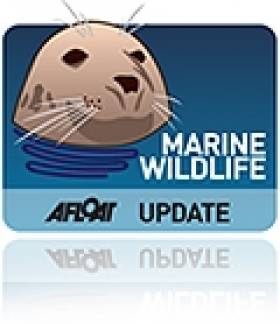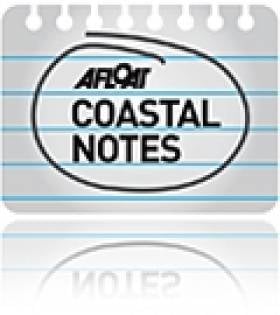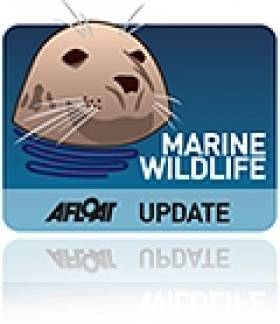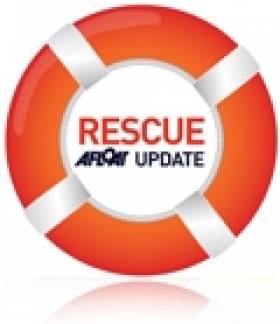Displaying items by tag: west cork
Video: Courting Humpback Whales Duel Off Baltimore
#MarineWildlife - Check out this wonderful video - via the Baltimore Photos Facebook page - of two male humpback whales fighting over a prospective female partner off West Cork late last year.
Richard O'Flynn, who posted the footage to YouTube, says: "We were following two humpbacks for about 30 minutes when a third one turned up.
"What you're seeing here is the female to the right of the shot and her partner between her and the third humpback trying to keep him away from her. It went on for about one-and-a-half hours!"
O'Flynn said it was only his second time using the video camera "so please forgive the shake... and I was driving the boat at the same time!"
White-Tailed Sea Eagles Found Dead in Southwest
#MarineWildlife - RTÉ News reports on the discovery of two dead white-tailed sea eagles in Kerry and West Cork.
The bird found washed up near Glengariff in West Cork two weeks ago was confirmed as poisoned after a post-mortem at the State Laboratory in Celbridge.
According to its electronic tag, the female sea eagle was released in Kerry more than two years ago.
Meanwhile a second bird found in south Kerry earlier this week is also believed to have been died as a result of eating poisoned carrion - an illegal method sometimes employed to control crows and foxes preying on lambs.
A protected species under Irish law, some 100 while-tailed sea eagles were reintroduced to the wild in Killarney National Park from 2007 to 2011. Since that time more than a quarter have been found dead, with 12 of those cases confirmed as poisonings.
Lough Hyne Flint A Big Find For Archaeologists
#CoastalNotes - The recent discovery of a piece of worked flint at Lough Hyne on the West Cork coast could unlock the secrets of 4,000 years of settlement in the area.
Cork's Southern Star reports that the archaeological find at Ballinard on the marine lake and nature reserve is what remains of a core piece of flint "which would have been worked on, or knapped, by a skilled stone worker" to create tools such as blades and arrowheads.
It's unknown how the flint came to be in the area, as it is not a rock common to West Cork, though it is supposed that it arrived either as a result of trade with people from the Antrim area - Ireland's main source of flint - or brought ashore as 'moonstones' by fishermen off what is now Galley Head.
The Southern Star has much more on the story HERE.
Humpback Sightings Brighten a Dreary Winter in Baltimore
#MarineWildlife - The Sunday Independent reports on the recent visits by humpback whales to Baltimore that have taken the West Cork village by storm.
"The familiar vocabularies of fishing and sailing, which normally permeate worthwhile conversation in the village, have been temporarily relegated," writes Louis Jacob.
"Bubble-netting, breaching, pectoral-slapping and tail-fluking are just a few of the terms driving the discourse in the village now."
The humpback pod was captured on video a fortnight ago feeding on "the abundance of Atlantic sprat" shoaling along the coast - and their arrival has "triggered an epidemic of humpback-mania in Baltimore", lighting a spark of life during the slow December weeks.
Jacob also spoke to local photographer Simon Duggan, who was lucky enough to capture some stunning images of the breaching whales - which has in turn aided the sightings records of the Irish Whale and Dolphin Group (IWDG).
Meanwhile, Niamh Naughton of veterinary X-ray firm BCF Technology was delighted to hand over a cheque for £2,000 (€2,480) on behalf of the BCF Foundation to Pádraig Whooley of the IWDG recently to support its cetacean conservation work.
Whooley commented: “We are so grateful for the support from BCF. This money will go into supporting us help people record sightings and strandings around the coastline of Ireland.
"Last year there were about 1,500 sightings of whales and dolphins in our waters.”
Humpback, Fin Whales Moving East Along Cork Coast Says IWDG
#MarineWildlife - The Irish Whale and Dolphin Group (IWDG) reports of another "frenzy of activity" while on a whale research cruise off West Cork this week.
The 'members only' trip on Wednesday 5 December took in the hotspot west of Reen Pier in Union Hall "where humpback and fin whales have enthralled hundreds of whale watchers and wildlife enthusiasts alike in recent weeks," according to IWDG sightings co-ordinator Pádraig Whooley.
When it soon became clear that most of the whales had left the area, the team headed east to return an ill member to shore.
"This turn of events proved almost karmic," says Whooley, "as not long after dropping our colleague back to Reen Pier, we started getting text messages from IWDG observers Tim Feen and Chris O'Sullivan of both humpback and fin whales well to the east on the Clonakilty Bay side of Galley Head."
Racing against the fading afternoon light, the boat made it to the scene to witness the blows first of fin whales, then humpbacks - at least five of the latter and seven of the former - and confirming them as the giants previously seen between the Kedge and Stags.
The team collected biopsy samples from most of the relaxed pod, including one that is suspected to be a female humpback with a calf.
"Since then, the weather has been very poor," says Whooley, "but there are still sufficient reports coming into IWDG to suggest to us that the large whale activity is slowly pushing east."
The IWDG is also collaborating with the BBC's WinterWatch programme next week, which is hoping to follow up on last year's AutumnWatch special on fin whales from East Cork and Waterford by filming humpback whales in West Cork.
Members of the public or whale-watchers are encouraged to report any sightings they might witness over the weekend to the IWDG by using the 'Report a sighting' link on the home page at iwdg.ie.
New Lifeboat Station for Castletownbere RNLI
#RNLI - The Southern Star reports that Castletownbere RNLI in West Cork has a found a permanent home with the construction of a new station and pontoon.
Coxswain Brian O'Driscoll told the paper that the new station was "a long time coming".
The new €950,000 facility, replacing temporary accommodation that the lifeboat crews had occupied for 15 years, was build on reclaimed land provided by the Department of the Marine.
It comprises a two-storey lifeboat station and a pontoon from where the all-weather lifeboat can be launched for missions such as the fishing trawler grounded off Bere Island last month.
When completed, the building will also boast a crew changing room, training room, operations office and a charity shop.
The new station is scheduled to be open in the spring. The Southern Star has more on the story HERE.
Exclusive Footage of Tit Bonhomme Rescue on RTÉ
#MARITIME TV PROGRAMMES - Footage from the rescue of the only survivor of the Tit Bonhomme tragedy in West Cork last January will feature in the first of a new series of Ireland's Search and Rescue tomorrow evening on RTÉ One.
Abdul Mohammed, 43, survived the sinking of the trawler when it ran around in rough seas near Adam's Rock at Glandore Harbour, after he was able to reach the shore.
His brother Wael Mohammed (35) died along with skipper Michael Hayes (52), Saied Ali Edlin (26), Attea Shaban (26) and Kevin Kershaw (21) when the boat went down.
As the Southern Star reports, Mohammed will feature in Sunday's programme talking to presenter Claire Byrne about his struggle to survive the tragedy, while exclusive footage from the Irish Coast Guard's Rescue 117 helicopter, the Irish naval vessel LE Niamh and Naval Service divers shows the search for the missing fisherman in the wake of the incident - a first for Irish television.
The first episode of the six-part series will be broadcast this Sunday 18 November at 6.30pm on RTÉ One.
Glandore Harbour Yacht Club Gets New Clubhouse
#GLANDORE HARBOUR - After 27 years, Glandore Harbour Yacht Club has finally acquired a clubhouse in the picturesque West Cork harbour village.
"It may have taken a long time but the reward is that we have ended up with a perfect location for our clubhouse," says Commodore Diarmuid O’Donovan in a message on the club website.
The new facility has been funded by a combination of fundraising from past events and a mortgage of €140,000. More fundraising is required to may off the mortgage while the club begins work on the premises to bring them up to fire and disability certification.
"We are a small but thriving club and I am sure this will show as we continue to fundraise for the better of the club," says O'Donovan.
"We have come a long way over the past few years. Membership has grown significantly. We also need to update our sail training fleet and equipment to facilitate the expansion of the club. Junior sailing is the lifeline and future of our club.
"It is wonderful to see the enthusiasm of all involved and I am sure the clubhouse will be a welcome asset for all sailors alike."
Commodore O'Donovan also thanks the club's members and supporters, as well as past and present committee members, for the time and effort they have given to date.
Baltimore Whale Carcass Creating 'Rancid Oil Slick' in Conservation Area
#BALTIMORE WHALE - Nine weeks after the tragic demise of the Baltimore Harbour fin whale, its carcass is still afloat off West Cork, creating a “rancid oil slick” in a special conservation area, according to a local resident.
Tom McCarthy contacted Afloat.ie with the above image of the 65ft whale carcass, which was towed out to the grey seal breeding ground off the Carthys Islands in Roaringwater Bay and has apparently been left to rot.
“It has been left here since the middle of August to decay,” says Tom. “The rancid oil slick is clearly visible and extends for over 1km on relatively still days, the smell is horrendous."
As previously reported on Afloat.ie, plans were afoot to sink the fin whale carcass that was trapped in Baltimore Harbour in mid-August and endured a harrowing few days trapped in Baltimore Harbour before it died from what's presumed to be a combination of illness and injury.
Tom McCarthy claims that the National Parks and Wildlife Service (NPWS) has washed its hands of the situation, considering the enormous marine mammal carcass to be a natural occurrence "even though the animal beached and died several miles [away and] was wrapped in a net and towed to its final resting position".
The location is in a Special Area of Conservation - yet according to Tom, no risk assessment appears to have been carried out beforehand.
"Ten minutes on the internet would show that whales are perhaps the most contaminated animals in the world," he says. "Their blubber is contaminated with persistent organic compounds such as PCBs, DDT, dioxins, etc and the internal organs such as the liver and kidneys are 'high', 'very high' or 'staggeringly high' in mercury, cadmium, chromium, etc.
"Some beached whales are found to be so contaminated the whale itself has to be considered as hazardous waste and disposed of as such."
Tom notes that the area is fished extensively for shrimp, crab, lobster and pollock, and that the rotting carcass is in close proximity to several mussel farms.
"It seems inevitable that as the whale continues to decay and is eaten whatever contaminants were present prior to death will re-enter the food chain."
He compares the current situation to a similar whale carcass disposal in Sligo last year, where the flesh was cut off and sent for incineration while the bones were marked for later skeletal recreation and sent for composting.
Regarding the West Cork whale carcass, Tom says: "Some estimates say it will take three years for the whale to completely decay."
Tom adds that he has been in contact with Cork County Council and hopes to hear on Monday about plans for a more appropriate method of disposal for the whale carcass.
More On Power Boat Fireball Off West Cork
#BOAT FIRE - The Irish Independent has more on the incident in which a motor cruiser caught fire off West Cork at the weekend, as previously reported on Afloat.ie.
Denis Ryan, a car dealer from Inishannon in Co Cork, says he is lucky to be alive after a sudden fire engulfed his power boat off the Seven Heads Peninsula on Saturday afternoon.
Ryan was piloting his boat alone in the waters near Courtmacsherry when the incident occurred, destroying the plastic-hulled vessel in a matter of minutes.
His immediate distress signal was picked up by the Naval Service vessel LE Niamh which was in the area at the time, and Ryan himself was quickly rescued from the water by a passing yachtsman.



























